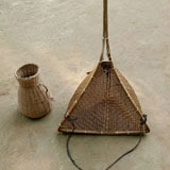Design Resource
Jakhoi and Khaloi
The Craft of Utensils
by
Introduction
Khaloi is one of the most commonly used fishing accessories in Assam. It is also called Kanyamur in the local language, as its form resembles the shape of a female waist. It is a small conical shaped pitcher woven from strips of the local species of bamboo called ‘Bijuli’. It is mostly used by the locals to keep fish during hand-net fishing.
Making of the Khaloi
Bijuli is a species of bamboo suited for weaving, because of its flexibility. It can be split easily and sized to fine strips. First, the outer dark green sheath of the bamboo is removed. The inner layer is further split to 1 mm thick using a cutting knife called the ‘Dao’. These are suitably sized to lengths 30 cm each.
Making the Base
A flat base is needed for the Khaloi to stand upright. To commence with, the strips are interwoven and suitably bent to create a square base. As we keep on introducing additional warps to the square. base a circular shape is formed.
Weaving the Body
We now have to form the hollow for the body of the pitcher. This is done by inserting a strong jute string into the base, the other ends of which are tied and held round the craftsmen’s knee.
With a tug of the string held tight, help to curve the base forward. As we continue with the weaving process from the base upwards, the base takes a curvy bend with the pressure applied from the feet. New warps are introduced in such a manner that the base is wider than the neck.
Water is sprinkled from time to time on the pitcher to make the strips supple and easy to mould. The weaving is continued, adding new warps in such a way that the circumference of the circle is gradually reduced till the body of the pitcher takes shape and we reach the neck portion.
Weaving the Neck
To form the narrow neck of the pitcher a metal bowl is held tight at the open end to act as a preform.
Now, a few strips from the body of the pitcher are used to tie the bowl and fix it in position.
The bamboo strips are woven around this preform and the narrow neck of the pitcher is woven. The preform is now removed.
Locking the Rims
After the completion of the narrow neck, the loose ends of the warps are again split into two to add more flexibility in forming the mouth during the weaving process. Once the mouth of the pitcher is formed, the ends of the warp are now uniformly cut.
A 2mm thick bamboo strip is introduced around the mouth of the pitcher. This acts as reinforcement for the rim making it stronger.
The loose ends of the weft are now folded over one after the other around the bamboo strip and simultaneously tied using a strong cane strip. Once we tie the bent strips to the circular frame, the loose ends are tucked inside the pitcher to finish the mouth of the pitcher.






